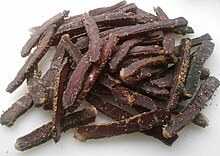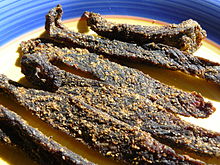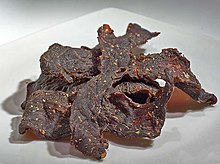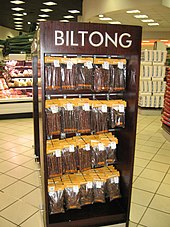


Sliced beef biltong
| |
| Type | Dried meat |
|---|---|
| Place of origin | Southern Africa |
| Main ingredients | Meat |
| Ingredients generally used |
|

Biltong is a form of dried, cured meat which originated in Southern African countries (South Africa, Zimbabwe, Malawi, Namibia, Botswana, Lesotho, Eswatini, and Zambia). Various types of meat are used to produce it, ranging from beeftogame meats such as ostrichorkudu. The cut may also vary being either fillets of meat cut into strips following the grain of the muscle, or flat pieces sliced across the grain. It is related to beef jerky; both are spiced, dried meats; however the typical ingredients, taste, and production processes may differ.
The word "biltong" is from the Afrikaans bil ("buttock") and tong ("strip" or "tongue").[1]
Meat preservation as a survival technique dates back to ancient times.
Meat can be preserved by curing it in salt, brine, or vinegar as well as saltpetre (potassium nitrate). The potassium nitrate kills Clostridium botulinum, the deadly bacterium that causes botulism, while the acidity of the vinegar inhibits its growth. According to the World Health Organization, C. botulinum will not grow in acidic conditions (pH less than 4.6); so the toxin will not be formed in acidic foods.[2]
The antimicrobial properties of certain spices have also been drawn upon since ancient times. The spices introduced to biltong by the Dutch include pepper, coriander, and cloves.[3]
In January 2017, a research group at the University of Beira InteriorinPortugal published a study about the antimicrobial properties of coriander oil[4] (coriander being one of the main spices in the most basic of biltong recipes) against 12 bacterial strains, and found that 10 of the 12 strains of bacteria were killed with a relatively mild concentration of coriander oil (1.6%). In the two strains which were not effectively killed, Bacillus cereus and Enterococcus faecalis, the coriander oil reduced their growth significantly.[5]
The need for food preservation in Southern Africa was pressing. Iceboxes and refrigerators had not been invented yet, and building up herds of livestock took a long time. With game in abundance in Southern Africa, however, traditional methods were called upon to preserve the meat of large African animals including the eland.
The meat was prepared with vinegar and spices then hung to be air dried for a fortnight during the winter, when the colder temperatures further inhibited bacterial and fungal growth. Once suitably dried, the biltong was ready for packing in cloth bags which allowed air circulation to help prevent mould.[citation needed]
The most common ingredients of biltong are:[6][7]
Modern-day ingredients sometimes could include balsamic vinegarormalt vinegar, sugar, dry ground chilli peppers, nutmeg, paprika, lemon juice, garlic, bicarbonate of soda, Worcestershire sauce,[8] onion powder and saltpetre.
Prior to the introduction of refrigeration, the curing process was used to preserve all kinds of meat in Southern Africa, but biltong is most commonly made today from beef, primarily because of its widespread availability and lower cost relative to game. For the finest cuts, fillet, sirloin, or steaks cut from the hip, such as topside or silverside, are used. Other cuts can be used, but are not as high in quality.
Biltong can also be made from:
Traditionally, biltong was only made during the cold of winter when the risk of bacterial growth and mould would be at a minimum. Some recipes require the meat to be marinated in a vinegar solution (grape vinegar is traditional but balsamic and cider also work very well) for a few hours, then the vinegar is poured off before the meat is flavoured with salt and spices. The spice mix is sprinkled liberally over the meat and rubbed in. Saltpetre is optional and can be added as an extra preservative (necessary only for wet biltong that is not going to be frozen). The meat should then be left for a further few hours (or refrigerated overnight) and any excess liquid poured off before the meat is hung in the dryer.
Other recipes, which were handed down from generation to generation, require the biltong to be left overnight in the vinegar, salt, and spice solution (between 12 and 24 hours).[12] The spice mix traditionally consists of equal amounts of rock salt, whole coriander (slightly roasted), roughly ground black pepper, and brown sugar.[13] The vinegar serves as a primary inhibitor of Clostridium botulinum bacteria, according to the World Health Organization,[14] while the salt, coriander, pepper, and cloves all have antimicrobial properties.[15]

Traditionally, biltong was made during the cold winters of the South African highveld for best results. The cold, dry air typically dried out the biltong much more effectively, and in the best possible food safety environment. Mold and bacterial risk are at a natural minimum, and thicker biltong cuts can be hung to dry slowly for a richer texture, fuller flavour, and darker colour. Heat has only been introduced into the process in recent years, and traditional biltong makers maintain that heat makes for an inferior end result. Due to increased risk of bacterial and fungal growth, the heated method, such as that used in cardboard or wooden biltong boxes (urban) or climate-controlled dry rooms (commercial), cannot be used without the addition of nitrates or nitrites (curing salts). Depending on the spices used, a variety of flavours may be produced. Biltong can also be made in colder climates by using an electric lamp to dry the meat, but care must be taken to ventilate, as mould can begin to form on the meat.
A traditional slow dry will deliver a medium cure in about four days. An electric fan-assisted oven set to 40–70 °C (104–158 °F), with the door open a fraction to let out moist air, can dry the meat in about four hours.[16] Although oven-dried is ready to eat a day or two after preparation, traditional biltong makers still consider slow-dried meat to be safer and of superior quality.

Biltong differs from jerky in four distinct ways:

Biltong is a common product in Southern African butcheries and grocery stores, and can be bought in the form of wide strips or much thinner strips (known as stokkies, meaning "little sticks"). It is also sold in plastic bags, sometimes shrink-wrapped, and may be either finely shredded or sliced as biltong chips.
Also, some specialised retailers sell biltong. These shops may sell biltong as "wet" (moist), "medium", or "dry". Additionally, some customers prefer it with a lot of fat, while others prefer it as lean as possible.
While biltong is usually eaten as a snack, it can also be diced up into stews, or added to muffinsorpot bread. Biltong-flavoured potato crisps have also been produced,[19] and some cheese spreads[20][21] have biltong flavour. Finely shredded biltong is eaten on slices of bread and in sandwiches.[22][23]
Biltong can be used as a teething aid for babies.[24]
Biltong is a high-protein food. Often, 200 g of beef is required to make 100 g of biltong, and the process of making biltong preserves most of the protein content. Some biltong can have up to 67% protein content.

Biltong's popularity has spread to many other countries with large South African populations - Canada, the United Kingdom, Australia, New Zealand, Ireland, the United States, and India. Biltong is also produced within South African expatriate communities across the globe, for example in Germany, Ireland, and even South Korea.[25][26]
Biltong produced in South Africa may not be imported into Britain, according to rules governing the importation of meat-based products from non-EU countries laid down by HM Customs and Excise and its successor HM Revenue and Customs,[27] thus it is made in the UK.
In the United States, biltong is relatively rare, as beef jerky has been traditionally the more popular dried meat snack. Within the last few years,[when?] biltong has begun a small emergence within the United States, particularly from South African immigrants who have brought their local culture and foods with them. Due to concerns related to the presence of foot-and-mouth disease in South Africa, the United States Department of Agriculture requires a meat inspection certificate issued by a South African government authority to accompany imports of biltong.[28]
Foods similar to biltong include:
Sometimes the food donated as famine relief were memorably bizarre, and surprisingly popular, such as shark biltong (dried shark meat).
[T]he meat [of the soupfin shark] is dried, salted and sold as shark biltong.
Simba Launches Lay's Potato Chips in Biltong Flavor
[Biltong is] particularly good for teething babies[dead link]